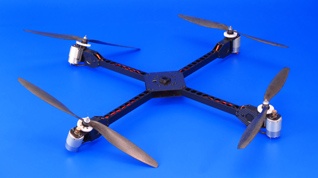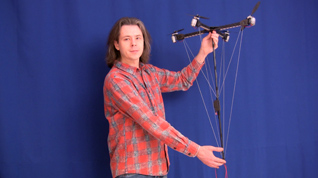Tethered Solutions
Wired Power Supply for Drones
The wired power supply makes it possible for the aircraft to stay in the air for an unlimited amount of time. This makes it possible to significantly expand the number of areas where these aircraft can be used. Examples of situations where such drones can be used include: border and frontline observation posts, video broadcasting of events, to carry mobile radio repeaters to extend the range of communications, to lift up lighting equipment, to act as a construction crane, to provide decorative effects, and to attract attention and publicity.
SkyTorch - hovering light source
It uses four 48-volt DC motors. The motors and the on-board power supply are connected in series. The power is fed from a 230-volt AC network through a rectifier with a capacitor. 310 volts DC are supplied. The length of the wire is 40 meters. The voltage loss across the wire is approximately 100 volts. The illuminating LEDs are connected in series with one another and in parallel with the motors. Connected in this way, the motor revolutions are not constant and are not regulated. For aircraft control and stability, the rotors are made so the plane of rotation can be tilted. This enables the frame of the aircraft to be kept horizontal. The stable frame permits a directional light source to be attached to it. In addition to that, the aluminum frame acts as a heat dissipator for the LEDs. This prototype climbs to maximum altitude on the stressed wire. A shock absorber installed in the frame dampens buffeting from gusts of wind and protects the wire from breaking. This quadcopter's opposing rotors spin in opposite directions which enables it to set down safely in the event one or two of the four opposing rotors break.
|
|
 |
 |
The second prototype of a tethered drone
This prototype uses controllable RPM motors (the usual means of control). Each motor is fed from a separate voltage regulator. A 60-volt voltage limiter is connected in parallel with each regulator. The voltage regulators are connected in series and require 240 volts in aggregate. The power is fed from a 230-volt AC network through a rectifier with a capacitor (310 volts DC). The length of the wire is 50 meters. The aircraft can maneuver within the limits of the wire.
The third version of wire power feed for the multicopter
The commercially available aircraft, the DJI Inspire-1, features a power supply that supports battery charging during flight. The length of the wire is 20 meters, maximum voltage is 48 volts, maximum current is 20 amps.
The fourth prototype of a wired multicopter
The wire carries 310 volts of AC power at a frequency of 7 kHz. A transformer is installed on board that steps the voltage down to 16 Volts. A thin, Teflon-insulated, enameled wire is used. The maximum length of the wire is 400 meters. The aircraft twice set the record for altitude reached. On September 25, 2015, a record of 230 meters was set; on September 30, 2015, the aircraft flew at an altitude of over 300 meters.
Ecilop Observer is the fifth model of tethered aircraft
For reasons of safety, a ground-based power supply unit with extra-low voltage is used (maximum 60 volts DC with respect to ground, 120 volts total). The power supply automatically adjusts to the aircraft's on-board voltage and automatically compensates for voltage lost across the wire. The length of the wire is 100 meters.
|